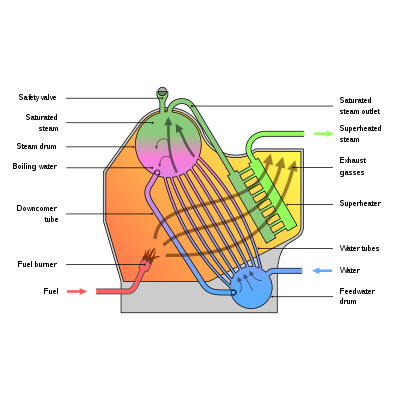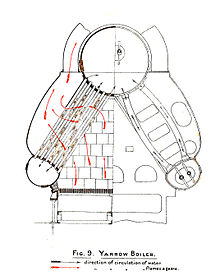Water-tube boiler

Ahigh pressure watertube boiler[1](also spelled water-tube and water tube) is a type ofboilerin which water circulates in tubes heated externally by fire. Fuel is burned inside thefurnace,creating hot gas which boils water in the steam-generating tubes. In smaller boilers, additional generating tubes are separate in the furnace, while larger utility boilers rely on the water-filled tubes that make up the walls of the furnace to generatesteam.
The heated water/steam mixture then rises into thesteam drum.Here, saturated steam is drawn off the top of the drum. In some[which?]services, the steam passes through tubes in the hot gas path, (asuperheater) to becomesuperheated.Superheated steam is a dry gas and therefore is typically used to drive turbines, since water droplets can severely damage turbine blades.
Saturated water at the bottom of the steam drum returns to the lower drum via large-bore 'downcomer tubes', where it pre-heats the feedwater supply. (In large utility boilers, the feedwater is supplied to the steam drum and thedowncomerssupply water to the bottom of the waterwalls). To increase economy of the boiler, exhaust gases are also used to pre-heat combustion air blown into the burners, and to warm the feedwater supply in aneconomizer.Such watertube boilers inthermal power stationsare also calledsteam generating units.
The olderfire-tube boilerdesign, in which the water surrounds the heat source and gases from combustion pass through tubes within the water space, is typically a much weaker structure and is rarely used for pressures above 2.4 MPa (350 psi). A significant advantage of the watertube boiler is that there is less chance of a catastrophic failure: there is not a large volume of water in the boiler nor are there large mechanical elements subject to failure.
A water-tube boiler was patented by Blakey of England in 1766 and was made by Dallery of France in 1780.[2]
Applications
[edit]"The ability of watertube boilers to be designed without the use of excessively large and thick-walled pressure vessels makes these boilers particularly attractive in applications that require dry, high-pressure, high-energy steam, including steam turbine power generation".[3]
Owing to their superb working properties, the use of watertube boilers is highly preferred in the following major areas:
- Variety of process applications in industries
- Chemical processing divisions
- Pulp and Paper manufacturing plants
- Refining units
Besides, they are frequently employed in power generation plants where large quantities of steam (ranging up to 500 kg/s) having high pressures i.e. approximately 16 megapascals (160 bar) and high temperatures reaching up to 550 °C are generally required. For example, theIvanpahsolar-power station uses two Rentech Type-D watertube boilers for plant warmup, and when operating as a fossil-fueled power station.[4]
Stationary
[edit]Modern boilers for power generation are almost entirely water-tube designs, owing to their ability to operate at higher pressures. Whereprocess steamis required for heating or as a chemical component, then there is still a small niche for fire-tube boilers. One notable exception is in typical nuclear-power stations (Pressurized Water Reactors), where the steam generators are generally configured similar to firetube boiler designs. In these applications the hot gas path through the "Firetubes" actually carries the very hot/high pressure primary coolant from the reactor, and steam is generated on the external surface of the tubes.
Marine
[edit]Their ability to work at higher pressures has led to marine boilers being almost entirely watertube. This change began around 1900, and traced the adoption ofturbinesfor propulsion rather than reciprocating (i.e. piston) engines – although watertube boilers were also used with reciprocating engines, and firetube boilers were also used in many marine turbine applications.
Railway
[edit]
There has been no significant adoption of water-tube boilers for railway locomotives. A handful of experimental designs were produced, but none of them were successful or led to their widespread use.[5]Most water-tube railway locomotives, especially in Europe, used theSchmidt system.Most werecompounds,and a fewuniflows.TheNorfolk and Western Railway'sJawn Henrywas an exception, because it used asteam turbinecombined with an electric transmission.[6]
- Rebuilt completely after a fatal accident
- Using aYarrow boiler,rather than Schmidt. Not successful and re-boilered with a conventional boiler.[7]
Hybrids
[edit]A slightly more successful adoption was the use of hybrid water-tube / fire-tube systems. As the hottest part of a locomotive boiler is thefirebox,it was an effective design to use a water-tube design here and a conventional fire-tube boiler as an economiser (i.e. pre-heater) in the usual position.
One famous example of this was the USABaldwin4-10-2No. 60000,built in 1926. Operating as acompoundat a boiler pressure of 2,400 kilopascals (350 psi) it covered over 160,000 kilometres (100,000 mi) successfully. After a year though, it became clear that any economies were overwhelmed by the extra costs, and it was retired to a museum display at the Franklin Institute in Philadelphia, Pennsylvania.[8]A series of twelve experimental locomotives were constructed at theBaltimore and Ohio Railroad's Mt. Clare shops under the supervision ofGeorge H. Emerson,but none of them was replicated in any numbers.[9]

The only railway use of water-tube boilers in any numbers was the Brotan boiler, invented byJohann Brotanin Austria in 1902, and found in rare examples throughout Europe, although Hungary was a keen user and had around 1,000 of them. Like the Baldwin, it combined a water-tube firebox with a fire-tube barrel. The original characteristic of the Brotan was a long steam drum runningabovethe main barrel, making it resemble aFlaman boilerin appearance.[10][11]
Road
[edit]While thetraction enginewas usually built using itslocomotive boileras its frame, other types of steam road vehicles such aslorriesandcarshave used a wide range of different boiler types. Road transport pioneersGoldsworthy GurneyandWalter Hancockboth used water-tube boilers in their steam carriages around 1830.
Mostundertype wagonsused water-tube boilers. Many manufacturers used variants of the vertical cross-tube boiler, includingAtkinson,Clayton,GarrettandSentinel.Other types include theClarkson'thimble tube' and theFodenO-type wagon'spistol-shaped boiler.[12]
Steamfire-enginemakers such asMerryweatherusually used water-tube boilers for their rapid steam-raising capacity.
Many steam cars used water-tube boilers, and the Bolsover Express company even made a water-tube replacement for theStanley Steamerfire-tube boiler.[13]
Design variations
[edit]This sectionneeds additional citations forverification.(October 2020) |
D-type boiler
[edit]The 'D-type' is the most common type of small- to medium-sized boilers, similar to the one shown in the schematic diagram. It is used in both stationary and marine applications. It consists of a large steam drum vertically connected to a smaller water drum (a.k.a. "mud drum" ) via multiple steam-generating tubes. These drums and tubes as well as the oil-fired burner are enclosed by water-walls - additional water-filled tubes spaced close together so as to prevent gas flow between them. These water wall tubes are connected to both the steam and water drums, so that they act as a combination of preheaters and downcomers as well as decreasing heat loss to the boiler shell.
M-type boilers
[edit]The M-type boilers were used in many US World War II warships including hundreds ofFletcher-class destroyers.Three sets of tubes form the shape of an M, and create a separately fired superheater that allows better superheat temperature control. In addition to the mud drum shown on a D-type boiler, an M-type has a water-screen header and a waterwall header at the bottom of the two additional rows of vertical tubes and downcomers.
Low water content
[edit]Thelow water contentboiler has a lower and upper header connected by watertubes that are directly impinged upon from the burner. This is a "furnace-less" boiler that can generate steam and react quickly to changes in load.
Babcock & Wilcox boiler
[edit]
Designed by the American firm ofBabcock & Wilcox,this type has a single drum, with feedwater drawn from the bottom of the drum into a header that supplies inclined water-tubes. The watertubes supply steam back into the top of the drum. Furnaces are located below the tubes and drum.
This type of boiler was used by theRoyal Navy'sLeander-classfrigatesand inUnited States NavyNew Orleans-class cruisers.
Stirling boiler
[edit]TheStirling boilerhas near-vertical, almost-straight watertubes that zig-zag between a number of steam and water drums. Usually there are three banks of tubes in a "four drum" layout, but certain applications use variations designed with a different number of drums and banks.
They are mainly used as stationary boilers, owing to their large size, although the large grate area does also encourage their ability to burn a wide range of fuels. Originally coal-fired in power stations, they also became widespread in industries that produced combustible waste and requiredprocess steam.Paper pulp mills could burn waste bark, sugar refineries theirbagassewaste. It is a horizontal drum type of boiler.
Yarrow
[edit]
Named after its designers, the thenPoplar-basedYarrow Shipbuilders,this type ofthree-drum boilerhas three drums in adeltaformation connected by watertubes. The drums are linked by straight watertubes, allowing easy tube-cleaning. This does, however, mean that the tubes enter the drums at varying angles, a more difficult joint tocaulk.Outside the firebox, a pair ofcold-legpipes between each drum act asdowncomers.[14]
Due to its three drums, the Yarrow boiler has a greater water capacity. Hence, this type is usually used in oldermarineboiler applications. Its compact size made it attractive for use in transportablepower generationunits duringWorld War II.In order to make it transportable, the boiler and its auxiliary equipment (fuel oil heating, pumping units, fans etc.),turbines,andcondenserswere mounted on wagons to be transported byrail.
White-Forster
[edit]The White-Forster type is similar to the Yarrow, but with tubes that are gradually curved. This makes their entry into the drums perpendicular, thus simpler to make a reliable seal.[14]
Thornycroft
[edit]
Designed by the shipbuilderJohn I. Thornycroft & Company,the Thornycroft type features a single steam drum with two sets of watertubes either side of the furnace. These tubes, especially the central set, have sharp curves. Apart from obvious difficulties in cleaning them, this may also give rise to bending forces as the tubes warm up, tending to pull them loose from the tubeplate and creating a leak. There are two furnaces, venting into a common exhaust, giving the boiler a wide base tapering profile.[14]
Forced circulation boiler
[edit]In aforced circulation boiler,apumpis added to speed up the flow of water through the tubes.[15]
Other types
[edit]- O-type boiler
- A-type boiler
- Flex-tube boiler
- M-type control superheater
See also
[edit]- Clarkson thimble tube boiler
- Corner tube boiler
- Internally rifled boiler tubes(also known as serve tubes)
- Three-drum boiler
References
[edit]- ^"Recommended Guidelines for the Care of Power Boilers"(PDF).Archived fromthe original(PDF)on 2016-10-11.Retrieved2013-11-21.
- ^Marshall, Chapman Frederick (16 December 2014).A History of Railway Locomotives down to the End of the Year 1831.BoD – Books on Demand.ISBN9783845712871– via Google Books.
- ^"Boiler Efficiency: Water Tube Boilers".Archived fromthe originalon 2016-03-09.Retrieved2014-06-15.
- ^"eCRMS"(PDF).Docketpublic.energy.ca.gov.Retrieved2018-09-24.
- ^"High Pressure Steam Locomotive Technology".Loco Locomotive gallery. Archived fromthe originalon 2018-07-22.Retrieved2010-09-14.
- ^"The Jawn Henry".Trains Magazine.Retrieved2008-10-28.
- ^"LNER 10000 High Pressure Locomotive".Loco Locomotive galleryD&H 1402 James Archibald.Archived fromthe originalon 2018-07-22.Retrieved2010-09-14.
The Delaware and Hudson E7 class of water tube boiler locomotives consisted of three examples 1400-1402
- ^"Baldwin 60000".Loco Locomotive gallery.
- ^See chapter on "Experimentals" inSagle, Lawrence W. (1964).B&O Power.Staufer. p. 288 ff.
- ^"Brotan".Loco Locomotive gallery. Archived fromthe originalon 2018-07-22.Retrieved2010-09-14.
- ^"Brotan".
- ^Kelly, Maurice A. (1975).The Undertype Steam Road Waggon.Cambridge: Goose and Son.ISBN0-900404-16-7.
- ^Harris, Karl N. (1 June 1967).Model Boilers and Boilermaking(New ed.).Kings Langley:Model & Allied Publications.ISBN978-0852423776.OCLC821813643.OL8281488M.
- ^abcStokers' Manual(PDF)(1912 ed.).London:His Majesty's Stationery OfficeviaEyre & Spottiswoode.1912 [1901].ASINB00IZEYVAS.OCLC222437497.OL18715300M.Archived(PDF)from the original on 15 March 2021.Retrieved28 June2021– via Friends of the Cerberus.
- ^Newest on Process Equipments (2012-11-25)."Boilers circulation systems: natural circulation and forced circulation".Enggcyclopedia.Retrieved2013-09-30.
External links
[edit]- Robertson, Leslie Stephen (10 October 2018) [1901].Water-Tube Boilers: Based on a Short Course of Lectures Delivered at University College, London.New York:D. Van Nostrand Company.ISBN978-0342103232.OCLC556436534.OL32303266M.Retrieved28 June2021– viaInternet Archive.
